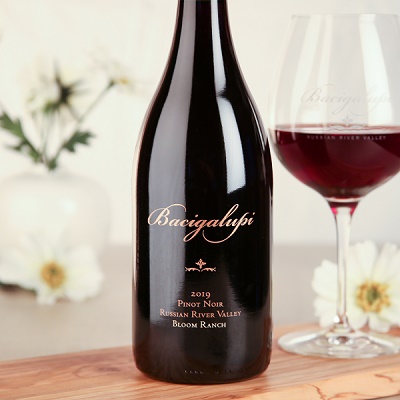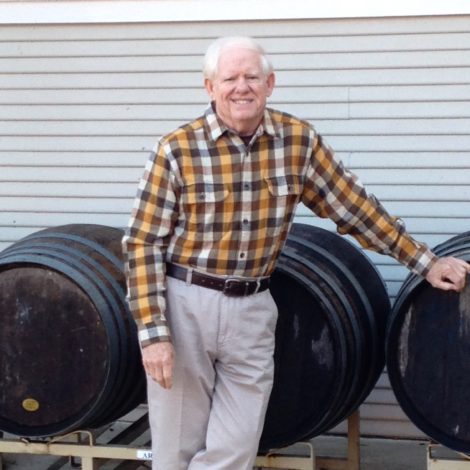Plain Winespeak About Clones of Pinot Noir – Rusty Gaffney
Rusty Gaffney
The Prince of Pinot
We are thrilled to have good friend and Pinot Noir professional Rusty Gaffney as our guest contributor for our 2021 Spring Newsletter. Rusty is a retired ophthalmologist who has had a love affair with Pinot for over 40 years. After retiring Rusty decided to devote his energies to writing The PinotFile, an online newsletter that was among the first to be solely dedicated to Pinot Noir. Rusty is considered one of the foremost writers on Pinot Noir and he has amassed an enthusiastic reader base throughout the world. With the release of our 2019 Pinot Noir’s, and the introduction of our newest single clone, the Bloom Ranch we asked Rusty to give us a quick run down of the Pinot Noir clones and his evaluation of each wine.
Plain Winespeak About Clones of Pinot Noir
The subject of Pinot Noir clones is amazingly complex. Serious Pinot Noir aficionados love to wax endlessly about clonal differences in Pinot Noir wines but for those who want to simply revel in the pleasures of Pinot Noir on a basic level, I will try to clarify and simplify the subject of clones.
The word clone is from the Greek word for twig. A clone is a separate vine genetically identical to its mother vine. It has the same growth habit, flavors and ripening time compared to the vine it originated from. Clones are propagated asexually by taking grafts or cuttings from a mother vine.
Cuttings that are taken from different vines that do not have a common parent and thus have a diverse genetic heritage are referred to as selections.
Clones are registered by the Foundation Plant Services (FPS at UC Davis and certified by ENTAV (Etablissement National Technique pour l”Amelioration de la Viticulture) in southern France. A certified clone is propagated from the same parent plant, tested for specific viruses and kept clean. These certified cloned vines are then named or numbered, propagated on site and cuttings made available through nurseries for winegrowers. Think of certification as a pedigree.
Clones offer different colors, aromas, flavors, texture, tannins, acidity and ripeness. They may perform better or worse in certain soils and climates so clones must be matched to an appropriate site. In other words, site trumps clone.
Pinot Noir clones planted in California do not produce wines with exactly the same characteristics as wines made by the identical clones grown in Burgundy, France. All Pinot Noir clones planted in North American originally came from France. The use of Pinot Noir clones in new plantings has been in widespread use domestically for over 40 years. There are two classes of Pinot Noir clones in California and Oregon: the heritage clones and the Dijon clones.
The heritage clones originated from grapevine cuttings that were either legally or illicitly (so-called “suitcase” selections) imported into the United States, virus-tested, treated to eliminate viruses and certified by FPS. They include Wädenswil, Pommard, Martini, Mount Eden, Swan, Calera and Hanzell. There are also non-certified “clones” known in the vernacular as David Bruce, Chalone, Pisoni, Rochioli, Wente, Coury and faux 828. The heritage clones are consistent performers.
The story of Dijon clones is intriguing. The vineyards in the Cotê d’Or of Burgundy, France, were performing poorly in the 1950s due to viral infestation among other afflictions and vignerons in Burgundy were dissatisfied with the quality of their wines. Researchers at the time found that Pinot Noir vines were susceptible to virus infestation just like today while humans are suffering from the COVID-19 pandemic. A viral infestation of vines limits the productivity of the vine and the quality of the grapes just as viruses limit the performance of infected humans.
The researchers at the University of Dijon conceived of the idea of taking buds from vines showing no evidence of viral disease and possessing desirable characteristics to create “mother” vines. These mother vines were then used to establish new healthy vineyards and improve the quality of Pinot Noir wines in Burgundy. The first Dijon clones of Pinot Noir arrived in the United States in 1987-1988. The lab technicians at Oregon State University received the first imported Pinot Noir vines from ENTAV and nicknamed the cuttings “Dijon clones” after the return address on the shipping container. This has remained part of viticulture lexicon.
Today, there are 47 certified Dijon clones of Pinot Noir but the most widely planted domestically include 113, 114, 115, 459, 667, 777 and 943. All vines with a unique certification number are propagated from the same parent mother vine and the origin and authenticity of the clones are guaranteed. The unique certification number is not of any significance other than an accession number as each new clone has been added to the Dijon collection.
Single Dijon clones may be vinified as a stand-alone Pinot Noir (115 is the most common). Of the most widely planted Dijon clones, the most popular combination is 115, 667 and 777. It is not unusual for the Dijon clones to be blended with any one of several heritage clones. Some believe that a blend of clones can make a wine that is greater than the sum of its parts.
The 2019 Bacigalupi Russian River Valley Pinot Noirs offer the opportunity to taste both single clone wines and a clonal blend wine. Each one of the wines makes a personality statement and offers a distinctly different organoleptic experience (experience via the senses).
 2019 Bacigalupi Goddard Ranch Pinot Noir
2019 Bacigalupi Goddard Ranch Pinot Noir
100% Wente clone from the original home ranch purchased by Charles and Helen Bacigalupi in 1956. Karl and sons Ernest and Herman Wente planted Pinot Noir in the Livermore Valley of Alameda County and at Riva Ranch in Arroyo Seco of Monterey County and these plantings became the source of Wente clone Chardonnay and Pinot Noir. There is not a true certified Wente “clone” of Pinot Noir but rather it represents many selections including Wädenswil, Pommard and Martini clones. When Charles and Helen sourced Pinot Noir for their initial planting, they obtained Pinot Noir from Karl Wente’s vineyard in Livermore Valley. It is thought that the initial vines were Pommard clone. Subsequent cuttings of the originally planted Pinot Noir vines were established at Goddard Ranch and were the source of this wine. In this bottling, look for aromas and flavors of red cherry, strawberry preserves, spice and white pepper. The profile of this wine is similar organoleptically to the 100% Pommard Frost Ranch Pinot Noir albeit with redder fruit character.
2019 Bacigalupi Frost Ranch Pinot Noir
100% Pommard clone planted on a 60-acre parcel purchased by the Bacigalupi family in 1993. The Pommard clone originated from vine cuttings imported by Dr Harold Olmo, a UC Davis faculty member, directly from Burgundy in the 1940s and was certified by FPS in 1956. The Pommard clone became a workhorse in California vineyards by the 1970s and accounts for a large percentage of Pinot Noir plantings in Oregon. The Pommard clone is versatile and can be grown in all types of soils while reflecting the vineyard and vintage conditions. It is the one Pinot Noir clone that makes the most complete, most outstanding single clone wine. In this bottling, look for heady aromas and flavors of black cherry, Asian spice including five-spice, cola, sandalwood, tilled earth and woodsmoke.
 2019 Bacigalupi Bloom Ranch Pinot Noir
2019 Bacigalupi Bloom Ranch Pinot Noir
100% 828. The history of this selection is convoluted and confusing. For the full story, visit www.princeofpinot.com/article/1268/. Gary Andrus, the founder of Archery Summit Estate in the Willamette Valley of Oregon smuggled budwood from famous Burgundian vineyards into the United States in the early 1990s. The true origins of the cuttings will never be known. One cutting, termed ASW2, proved to be the best performer and the least virused. It was a Pinot droit variety in that its growth was upright rather than recumbent or prostrate like all other Pinot Noir clones planted domestically. Beginning in 1997, cuttings from ASW2 were widely distributed to wineries and nurseries throughout California and Oregon (since it was not certified, there were no restrictions on propagation). At some point, and for reasons that remain a mystery, ASW2 became known as clone 828. Perhaps Andrus thought it was the French Dijon 828 or simply wanted it to be 828. It is not the same as the true French Dijon clone 828 that has never been certified by FPS. Currently, the viticulture trade refers to ASW2 as “faux 828,” “suitcase 828,” or AS2. It also has been tagged the “Viagra clone” due to its upright growth and the “Don King clone” for the same reason. 828 is most often blended with other clones. In this bottling, look for deep color, more density and structure (tannin) yet balancing acidity, and characteristic aromas and flavors of black fruits – blackberry, boysenberry, black raspberry, plum, fresh raisin, and an earthy undertone. This is the most distinctive of the three single clone/selection Pinot Noirs when tasted side-by-side.
2019 Bacigalupi Russian River Valley Pinot Noir
A blend of Goddard Ranch Wente “clone,” Frost Ranch Wente “clone,” Frost Ranch Pommard clone and Bloom Ranch 828. This wine offers the typical characteristics of Russian River Valley Pinot Noir including a core of black cherry and black raspberry fruit combined with flavors of pie spice, cola, and anise. Sleek in texture, with a compliment of oak in the background, the wine has
agreeable tannins and a juicy finish. You get some of the blacker fruit of 828, the black cherry and cola of Pommard, and the red cherry compote of the Wente all blended in a harmonious, suave palate-pleasing experience. The pleasure centers of the brain light up with “PINOT” in all
caps!




